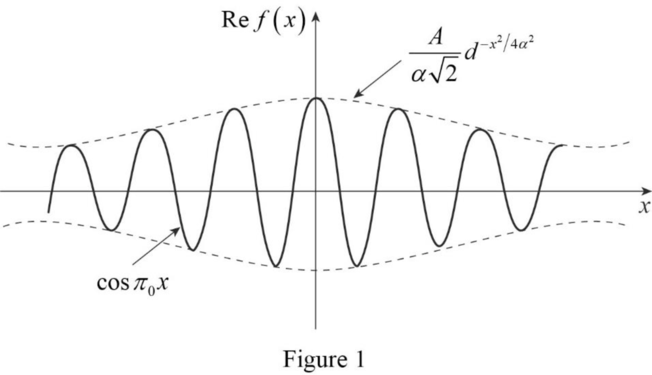
Concept explainers
(a)
The sketch of the real part of the matter wave pulse shape
(a)
Answer to Problem 35P
The real part of the matter wave pulse shape

Explanation of Solution
Write the expression for the matter wave pulse shape.
Here,
Write the expression for
Here,
Put the above equation in equation (I).
Simplify the above equation.
Take
Take the derivative of
Put the above two equations in equation (II).
Write the real part of
Here,
The plot of

Conclusion:
Therefore, the real part of the matter wave pulse shape
(b)
To show that the width of the matter wave pulse is
(b)
Answer to Problem 35P
It is showed that width of the matter wave pulse is
Explanation of Solution
Write the standard form of the Gaussian function with width
Comparison of equation (III) with the above expression shows that
Conclusion:
Therefore, it is showed that width of the matter wave pulse is
(c)
The width
(c)
Answer to Problem 35P
The width
Explanation of Solution
Compare equations (III) and (IV) to write the expression for
Rewrite the above equation for
Use equations (V) and (VI) to find the value of
Conclusion:
Thus, the width
Want to see more full solutions like this?
Chapter 5 Solutions
Modern Physics
- I need help with this problem and an explanation for the solution described below. (University Physics 1: Thermodynamics)arrow_forwardAn astronomer discovered two planets, X and Y, orbiting a star. From the perspective of the astronomer, the planets orbit the star as depicted in the figures. Five years ago, the planets were in the position shown in figure (a), with X, Y, and the star in a straight line. Today, planet X is in the position shown in figure (b), having made an angular displacement of 90.0°. If the radii of their orbits are in the ratio 5:4, what is the angular displacement of Y? (Give your answer in revolutions.) a b 1/5 × Equate Newton's law of universal gravitation with his second law, noting that the force in this case is a centripetal force, and use the relationship among angular velocity, radius, and linear velocity. Solve for the angular velocity of planet Y, and calculate the angular displacement in revolutions. revolutionsarrow_forwardQ4. A red ball is placed at point A in the figure below: Second quadrant 3.0 m Third quadrant y First quadrant Fourth quadrant 2.0 m 3.0 m 1.0 m 1. How many images are seen by an observer at point O? 3 images can be seen 2. What are the (x,y) coordinates of the image in the first quadrant? 3. What are the (x,y)coordinates of the image in the second quadrant? 4. What are the (x,y) coordinates of the image in the fourth quadrant? Tarrow_forward
- Can you please solve a, b and c showing all steps and final answersarrow_forwardI need help with this problem and an explanation for the solution described below. (University Physics 1: Thermodynamics)arrow_forwardI need help with this problem and an explanation for the solution described below. (University Physics 1: Thermodynamics)arrow_forward
- A bird dives to catch a fish at 5.00 m/s. Biologists say this bird makes a noise at 115.000 Hz. Field biologists are on a stationary boat as the bird approaches them, and they measure the frequency of the bird's sound to be 116.668 Hz. What is the air temperature that day, in degrees Fahrenheit? Express your answer to 3 sig figs. Note: This calculation is very sensitive to rounding. Keep to at least 4 places after the decimal point during your calculations.arrow_forwardA eats of Softe Four adult polar bears, each of mass 440. kg, are adrift on an ice floe in the seawaters of the Arctic Ocean. The ice floe is a rectangular slab, 8.0 m long by 4.0 m wide. If the top of the ice floe is 2.00 m above the water line, how thick is the slab of ice? Express your answer to 3 sig figs in either centimeters or meters.arrow_forwardI need help with this problem and an explanation for the solution described below. (University Physics 1: Thermodynamics)arrow_forward
 Classical Dynamics of Particles and SystemsPhysicsISBN:9780534408961Author:Stephen T. Thornton, Jerry B. MarionPublisher:Cengage Learning
Classical Dynamics of Particles and SystemsPhysicsISBN:9780534408961Author:Stephen T. Thornton, Jerry B. MarionPublisher:Cengage Learning Modern PhysicsPhysicsISBN:9781111794378Author:Raymond A. Serway, Clement J. Moses, Curt A. MoyerPublisher:Cengage Learning
Modern PhysicsPhysicsISBN:9781111794378Author:Raymond A. Serway, Clement J. Moses, Curt A. MoyerPublisher:Cengage Learning Principles of Physics: A Calculus-Based TextPhysicsISBN:9781133104261Author:Raymond A. Serway, John W. JewettPublisher:Cengage Learning
Principles of Physics: A Calculus-Based TextPhysicsISBN:9781133104261Author:Raymond A. Serway, John W. JewettPublisher:Cengage Learning Physics for Scientists and Engineers with Modern ...PhysicsISBN:9781337553292Author:Raymond A. Serway, John W. JewettPublisher:Cengage Learning
Physics for Scientists and Engineers with Modern ...PhysicsISBN:9781337553292Author:Raymond A. Serway, John W. JewettPublisher:Cengage Learning



